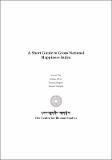| dc.description.abstract | Bhutan’s GNH Index is a multidimensional measure and it is linked
with a set of policy and programme screening tools so that it has
practical applications. The GNH index is built from data drawn
from periodic surveys which are representative by district, gender,
age, rural-urban residence, etc. Representative sampling allows its
results to be decomposed at various sub-national levels, and such
disaggregated information can be examined and understood more
by organizations and citizens for their uses. In the GNH Index,
unlike certain concepts of happiness in current western literature,
happiness is itself multidimensional – not measured only by
subjective well-being, and not focused narrowly on happiness that
begins and ends with oneself and is concerned for and with oneself.
The pursuit of happiness is collective, though it can be experienced
deeply personally. Different people can be happy in spite of their
disparate circumstances and the options for diversity must be wide.
The GNH Index is meant to orient the people and the nation
towards happiness, primarily by improving the conditions of notyet-happy
people. We can break apart the GNH Index to see where
unhappiness is arising from and for whom. For policy action, the
GNH Index enables the government and others to increase GNH in
two ways. It can either increase percentage of people who are happy
or decrease the insufficient conditions of people who are not-yethappy.
In the way the GNH Index is constructed, there is a greater
incentive for the government and others to decrease the
insufficiencies of not-yet-happy people. This can be done by
mitigating the many areas of insufficiencies the not-yet-happy face.
Not-yet-happy people in rural Bhutan tend to be those who attain
less in education, living standards and balanced use of time. In
urban Bhutan, not-yet-happy people are insufficient in non-material
domains such as community vitality and culture and psychological
well-being. In Thimphu, the capital, for example, the biggest
insufficiencies are in community vitality.
The GNH Index provides an overview of performance across 9
domains of GNH (psychological wellbeing, time use, community
vitality, cultural diversity, ecological resilience, living standard,
health, education, good governance). The aggregation method is a
version of Alkire-Foster method (2007, 2011). The index is aggregated out of 33 clustered (grouped) indicators. Each clustered
indicator is further composed of several variables. When unpacked,
the 33 clustered indicators have 124 variables, the basic building
blocks of GNH Index. Weights attached to variables differ, with
lighter weights attached to highly subjective variables. A threshold
or sufficiency level is applied to each variable. At the level of
domains, all the 9 domains are equally weighted as they are all
considered to be equally valid for happiness.
Three cut off points have been used to identify degrees of happiness.
Not all people need to be sufficient in each of 124 variables to be
happy. People are diverse in the ways and means they can have
fulfilling life. Not all variables need to be present to be happy.
People have freedom of choice in which ways they can make life
fulfilling, so not all variables have universal applicability. For such
reason, we divide the Bhutanese into four groups depending upon
their degree of happiness. We use three cutoffs: 50%, 66%, and 77%.
People who have achieved sufficiency in less than 50% are
‘unhappy’, and they comprise only 10.4% of the population. A total
of 48.7% of people have sufficiency in 50-65% of domains and are
called ‘narrowly happy’. A group of 32.6%, called ‘extensively
happy’, have achieved sufficiency in 66-76% – in between 6 and 7
domains. And in the last group, 8.3% of people are identified as
‘deeply happy’ because they enjoy sufficiency in 77% or more of
weighted indicators – which is the equivalent of 7 or more of the
nine domains.
In order to have one overall index, the GNH cut off was set at 66% of
the variables, which is the middle cutoff used above. People can be
considered happy when they have sufficiency in 66% of the
(weighted) indicators or more – that is, when they were identified as
extensively happy or deeply happy. The GNH Index value for 2010
is 0.743. It shows us that 40.8% of people in Bhutan have achieved
such happiness, and the remaining 59% - who are narrowly happy
or unhappy - still enjoy sufficiency in 57% (not 66% as required by
the index) of the domains on average. The cut off does make a
difference in the GNH Index. The middle cutoff gives a relatively
low score of GNH index is a result of its requirement that a diverse
set of conditions and states, represented by 124 variables, must be
simultaneously prevalent for a person to be robustly happy. It is a tougher measure because it is not focussed on survival like poverty,
but rather on flourishing over a wide array of conditions. However
the GNH Index, and the four categories of people – unhappy,
narrowly happy, extensively happy, and deeply happy – will be
reported and analysed when the GNH Index is updated over time,
as they are in this report. Taken together they will provide a
nuanced picture of the composition, diversity, and evolution of
GNH across Bhutan. | en |


